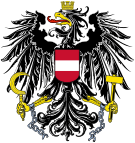| |||||||||||||||||||||||||||||||||||||||||||||||||||||||||||
183 seats in the National Council of Austria 92 seats needed for a majority | |||||||||||||||||||||||||||||||||||||||||||||||||||||||||||
|---|---|---|---|---|---|---|---|---|---|---|---|---|---|---|---|---|---|---|---|---|---|---|---|---|---|---|---|---|---|---|---|---|---|---|---|---|---|---|---|---|---|---|---|---|---|---|---|---|---|---|---|---|---|---|---|---|---|---|---|
| |||||||||||||||||||||||||||||||||||||||||||||||||||||||||||
 Results of the election, showing seats won by state and nationwide. States are shaded according to the first-place party. | |||||||||||||||||||||||||||||||||||||||||||||||||||||||||||
| |||||||||||||||||||||||||||||||||||||||||||||||||||||||||||
| This article is part of a series on the |
| Politics of Austria |
|---|
 |
Early parliamentary elections were held in Austria on 23 November 1986.[1] They were called by Chancellor Franz Vranitzky of the Socialist Party (SPÖ), as he was not prepared to continue the coalition government with new Freedom Party (FPÖ) leader Jörg Haider, who had ousted Norbert Steger at the party convention.
The SPÖ won the most seats, and formed a grand coalition with the Austrian People's Party (ÖVP), as neither were willing to work with Haider. The Green Alternative won eight seats, marking the first time a party other than the SPÖ, ÖVP and FPÖ had entered parliament since 1959 election. Voter turnout was 90%.[2]
YouTube Encyclopedic
-
1/5Views:82 94418 3681 09489 5434 338
-
Spanish General Election Results (1977-April 2019)
-
Spanish General Election Results (1977-November 2019)
-
Samizdat - Civil Disobedience & the Helsinki Process
-
Canadian Federal Election Results (1867-2015)
-
European Union Law - Lec 01 - Origins of EU / Widening - Deepening
Transcription
Results
 | |||||
|---|---|---|---|---|---|
| Party | Votes | % | Seats | +/– | |
| Socialist Party of Austria | 2,092,024 | 43.12 | 80 | –10 | |
| Austrian People's Party | 2,003,663 | 41.29 | 77 | –4 | |
| Freedom Party of Austria | 472,205 | 9.73 | 18 | +6 | |
| Green Alternative–Freda Meissner-Blau List | 234,028 | 4.82 | 8 | New | |
| Communist Party of Austria | 35,104 | 0.72 | 0 | 0 | |
| Action List – I've Had Enough | 8,100 | 0.17 | 0 | New | |
| Green Alternatives – Democratic List | 6,005 | 0.12 | 0 | New | |
| Carinthian Greens–VGÖ–VÖGA–Independent Councillors | 1,059 | 0.02 | 0 | 0 | |
| Total | 4,852,188 | 100.00 | 183 | 0 | |
| Valid votes | 4,852,188 | 98.22 | |||
| Invalid/blank votes | 88,110 | 1.78 | |||
| Total votes | 4,940,298 | 100.00 | |||
| Registered voters/turnout | 5,461,414 | 90.46 | |||
| Source: Nohlen & Stöver | |||||
References
- ^ Dieter Nohlen & Philip Stöver (2010) Elections in Europe: A data handbook, p196 ISBN 978-3-8329-5609-7
- ^ Nohlen & Stöver, p216






